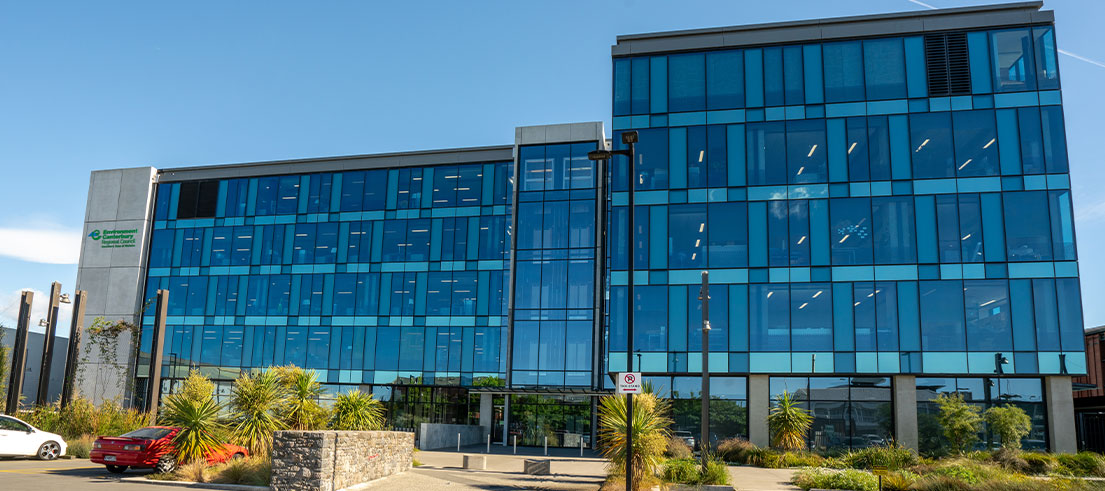
Environment Canterbury office becomes the first in NZ to achieve green certification trifecta
Our Tuam Street building has become the first in the country to be awarded three certifications for environmental performance.
"The triple ratings achievement demonstrates Environment Canterbury’s commitment to lead in climate change resilience, and we are very proud of this," said Director Corporate Services Giles Southwell.
"The work that has gone into getting to this point is important for long-term strategic planning and the identification of continuous improvement initiatives to reduce the building’s environmental impact."
A great example of reaching our carbon goals
The three certifications are a 4.5-star NABERSNZ (National Australian Built Environment Rating System – New Zealand) rating, a 4 Green Star Performance rating, and a net CarboNZero for Building Operations certification. Run by the New Zealand Green Building Council (NZGBC), each provides independent assessments of how a building is used, benchmarking that performance against various sustainability criteria and suggesting ways for improvement.
NABERSNZ benchmarks an office’s energy efficiency, and Green Star Performance looks at the use and operation of the building, from general waste and lighting to water use and cleaning products.
We used these to measure performance and reduce the building’s carbon emissions before offsetting any residual emissions in order to become a net-carbon-neutral building and to achieve the CarboNZero certification, developed by the NZGBC and Toitū Envirocare.
"This is a tremendous achievement and one that has taken a lot of work and focus. The built environment is 20 per cent of our emissions," NZGBC chief executive Andrew Eagles said.
"As the first in the country to successfully achieve all three, it provides a remarkable example of what can be done to reduce the carbon footprint and environmental impacts of our businesses and organisations.
"It provides a great example of what is needed if we are to reach our carbon goals."
The Tuam Street office was designed to be energy efficient, such as using a ground-source heat pump and installing a 55-kW solar panel array. We have also introduced a raft of initiatives to get staff on board with reducing their climate impact, including an innovative suite of green transport options.
"With 650 kaimahi/staff based at the Tuam Street office, transport to meetings and daily commutes are a major contributor to our carbon footprint. We’ve now got EV charging available and fantastic bike parking, lockers and changing rooms for people to walk, run, cycle or scoot in to work," Giles said.
"There’s a growing pool of electric bikes and scooters available for staff to use, and we have staff benefits that offer discounts for purchasing e-bikes and e-scooters at local businesses as well."
A sustainable journey requires long-term organisational commitment
Zerometric property sustainability consultant Adam Benli was the assessor for all three certifications, supporting and advising us on the various requirements and processes, as well as providing input on what the organisation could do to reduce its emissions.
"The NZGBC laid out a seamless pathway towards net zero building operations. Zerometric Ltd is proud to have helped Environment Canterbury on that journey," Adam said.
"It has been an effort that puts in place a best practice framework to help Environment Canterbury realise continual improvements in building operational performance. The goal is true net zero carbon building operations with minimal offsetting.
"Regulations are coming on this. My advice to anyone that owns a commercial building is get started now before you find yourselves in a position where these initiatives are formally regulated and therefore a lot more expensive."
Giles said ongoing efforts are being made to reduce our building’s environmental impact.
"To maximise the value of the asset and align with our goal of demonstrating climate change leadership, ongoing efforts are being made to reduce the building’s environmental impact by establishing and embedding sustainable practices," he said.
"Since 2018, progress has been staged so that continual improvement can be demonstrated within existing budgets and resourcing. These efforts include using cleaner energy sources, reducing overall energy and water consumption, reducing the amount of waste to landfill, and minimising the overall carbon footprint.
"To undertake a sustainable journey requires long-term organisational commitment and support. Our message for others is to utilise the NZGBC certifications to help to focus and prioritise organisational goals, and to identify those important opportunities for improvement."
For more information about the certifications, visit the New Zealand Green Council’s website.
